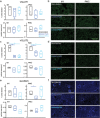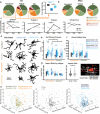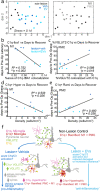This is a preprint.
Mesenchymal-Derived Extracellular Vesicles Enhance Microglia-mediated Synapse Remodeling after Cortical Injury in Rhesus Monkeys
- PMID: 37292805
- PMCID: PMC10246272
- DOI: 10.21203/rs.3.rs-2917340/v1
Mesenchymal-Derived Extracellular Vesicles Enhance Microglia-mediated Synapse Remodeling after Cortical Injury in Rhesus Monkeys
Update in
-
Mesenchymal-derived extracellular vesicles enhance microglia-mediated synapse remodeling after cortical injury in aging Rhesus monkeys.J Neuroinflammation. 2023 Sep 2;20(1):201. doi: 10.1186/s12974-023-02880-0. J Neuroinflammation. 2023. PMID: 37660145 Free PMC article.
Abstract
Understanding the microglial neuro-immune interactions in the primate brain is vital to developing therapeutics for cortical injury, such as stroke. Our previous work showed that mesenchymal-derived extracellular vesicles (MSC-EVs) enhanced motor recovery in aged rhesus monkeys post-injury of primary motor cortex (M1), by promoting homeostatic ramified microglia, reducing injury-related neuronal hyperexcitability, and enhancing synaptic plasticity in perilesional cortices. The current study addresses how these injury- and recovery-associated changes relate to structural and molecular interactions between microglia and neuronal synapses. Using multi-labeling immunohistochemistry, high resolution microscopy, and gene expression analysis, we quantified co-expression of synaptic markers (VGLUTs, GLURs, VGAT, GABARs), microglia markers (Iba-1, P2RY12), and C1q, a complement pathway protein for microglia-mediated synapse phagocytosis, in perilesional M1 and premotor cortices (PMC) of monkeys with intravenous infusions of either vehicle (veh) or EVs post-injury. We compared this lesion cohort to aged-matched non-lesion controls. Our findings revealed a lesion-related loss of excitatory synapses in perilesional areas, which was ameliorated by EV treatment. Further, we found region-dependent effects of EV on microglia and C1q expression. In perilesional M1, EV treatment and enhanced functional recovery were associated with increased expression of C1q + hypertrophic microglia, which are thought to have a role in debris-clearance and anti-inflammatory functions. In PMC, EV treatment was associated with decreased C1q + synaptic tagging and microglial-spine contacts. Our results provided evidence that EV treatment facilitated synaptic plasticity by enhancing clearance of acute damage in perilesional M1, and thereby preventing chronic inflammation and excessive synaptic loss in PMC. These mechanisms may act to preserve synaptic cortical motor networks and a balanced normative M1/PMC synaptic connectivity to support functional recovery after injury.
Conflict of interest statement
Figures









Similar articles
-
Mesenchymal-derived extracellular vesicles enhance microglia-mediated synapse remodeling after cortical injury in aging Rhesus monkeys.J Neuroinflammation. 2023 Sep 2;20(1):201. doi: 10.1186/s12974-023-02880-0. J Neuroinflammation. 2023. PMID: 37660145 Free PMC article.
-
Treatment with Mesenchymal-Derived Extracellular Vesicles Reduces Injury-Related Pathology in Pyramidal Neurons of Monkey Perilesional Ventral Premotor Cortex.J Neurosci. 2020 Apr 22;40(17):3385-3407. doi: 10.1523/JNEUROSCI.2226-19.2020. Epub 2020 Apr 2. J Neurosci. 2020. PMID: 32241837 Free PMC article.
-
Extracellular vesicles from mesenchymal stem cells reduce microglial-mediated neuroinflammation after cortical injury in aged Rhesus monkeys.Geroscience. 2020 Feb;42(1):1-17. doi: 10.1007/s11357-019-00115-w. Epub 2019 Nov 6. Geroscience. 2020. PMID: 31691891 Free PMC article.
-
Hydrogen-rich saline promotes microglia M2 polarization and complement-mediated synapse loss to restore behavioral deficits following hypoxia-ischemic in neonatal mice via AMPK activation.J Neuroinflammation. 2019 May 18;16(1):104. doi: 10.1186/s12974-019-1488-2. J Neuroinflammation. 2019. PMID: 31103039 Free PMC article. Review.
-
Cytokine Signalling at the Microglial Penta-Partite Synapse.Int J Mol Sci. 2021 Dec 7;22(24):13186. doi: 10.3390/ijms222413186. Int J Mol Sci. 2021. PMID: 34947983 Free PMC article. Review.
References
-
- Winship IR, Murphy TH. Remapping the Somatosensory Cortex after Stroke: Insight from Imaging the Synapse to Network. Neuroscientist. SAGE Publications Inc STM; 2009;15:507–24. - PubMed
-
- Edwards I, Singh I, Rose’meyer R. The Role of Cortisol in the Development of Post-Stroke Dementia: A Narrative Review. Heart Mind. 2022;6:151.
-
- Brown GC, Neher JJ. Microglial phagocytosis of live neurons. Nat Rev Neurosci. Nature Publishing Group; 2014;15:209–16. - PubMed
Publication types
Grants and funding
LinkOut - more resources
Full Text Sources

